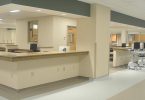At America’s universities, there are 141 medical schools and 29 osteopathic schools, as well as several podiatry programs. These schools are affiliated in turn with one or more teaching hospitals. For over 50 years, UHS Hospitals (at both UHS Wilson Medical Center and UHS Binghamton General Hospital) has been on this elite list of the nation’s teaching institutions. Its programs are accredited by such distinguished agencies as the Association of American Medical Colleges and the American Osteopathic Association. Each year, UHS attracts students and medical residents from across the country and around the world.
At any time, approximately 100 medical students and 80 residents are completing their medical training under the supervision of UHS attending physicians. In addition, UHS Chenango Memorial Hospital is a site for medical students as well as those studying to become nurse anesthetists.
America’s teaching hospitals drive and advance many of the world’s most important innovations in healthcare. “This gives our patients access to groundbreaking advances in treatments,” says Judith Spencer, director of Medical Education at UHS Hospitals. “Being so connected to leading-edge progress gives us a higher acuity in terms of the patients we treat and also allows us to provide a more comprehensive array of hospital services.”
With UHS attending physicians, research scientists and America’s future physicians all keenly focused on the latest treatments, technologies and life-saving healthcare, everyone must show up every day with their A-game. “Students ask a lot of questions, always pushing medicine to a higher level. To answer their questions, teaching physicians must rise to that higher level, too,” explains Rajesh Davé, MD, executive vice president for Clinical Integration and Chief Medical Officer at UHS, and dean of the Clinical Campus at Binghamton of Upstate Medical University. The result, Dr. Davé adds, is unparalleled continuity of care. “Someone is always reviewing a patient’s treatment plan. This system produces higher quality healthcare and greater safety controls.”
Reaching beyond the hospital walls, academic medical centers also maintain clinics, where residents treat walk-in patients who are often uninsured or underinsured. “Our residents gain valuable patient experience, and we’re also able to give back to our community,” Ms. Spencer says.
By placing tomorrow’s physicians in an environment where evolving medical knowledge is as highly valued as community outreach, the UHS system is able to consistently graduate stellar physicians — ready to take on the future.







